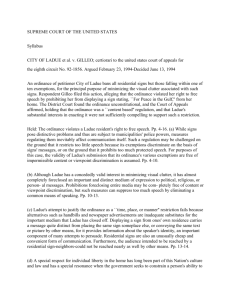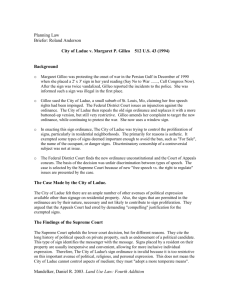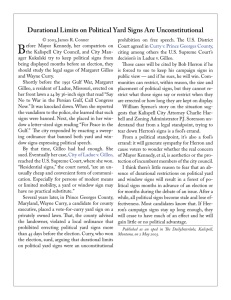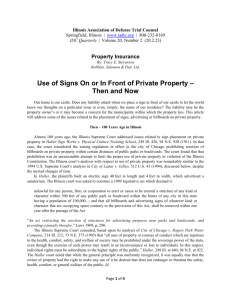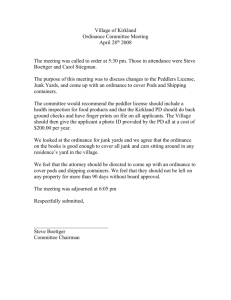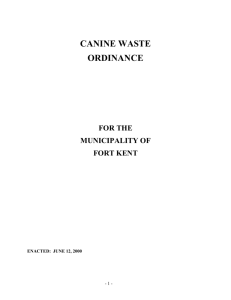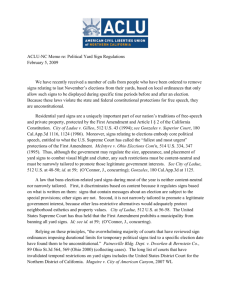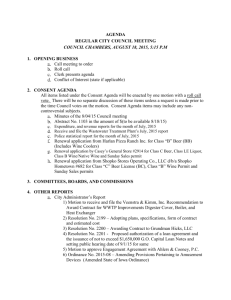Political Sign Provisions in Sign Ordinance public
advertisement
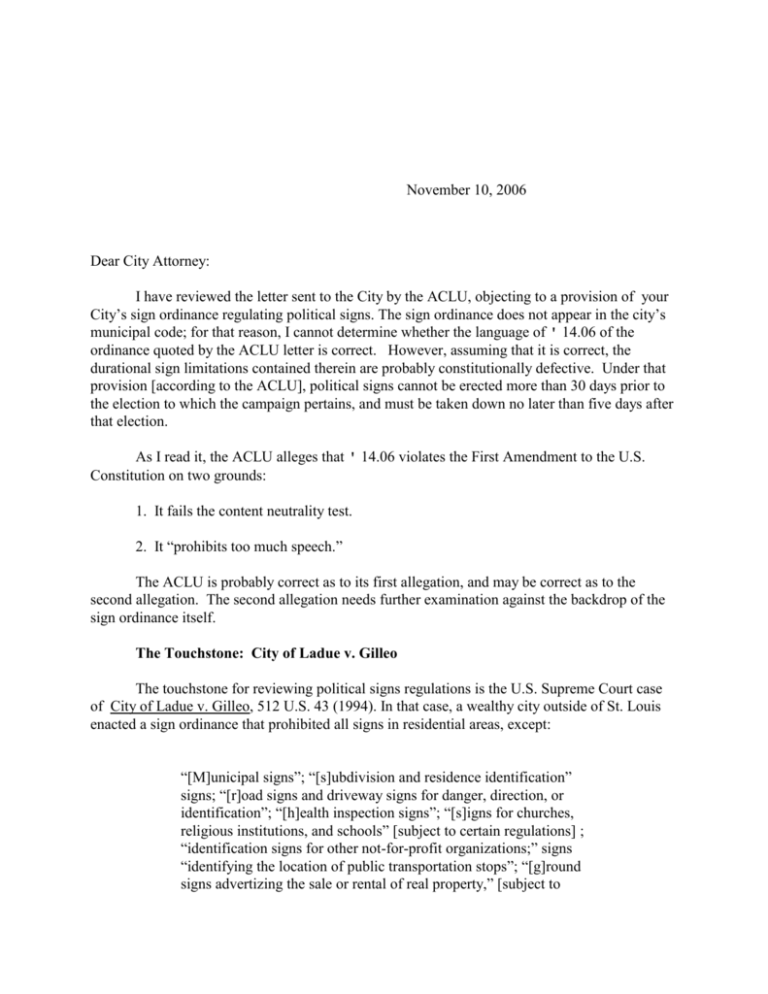
November 10, 2006 Dear City Attorney: I have reviewed the letter sent to the City by the ACLU, objecting to a provision of your City’s sign ordinance regulating political signs. The sign ordinance does not appear in the city’s municipal code; for that reason, I cannot determine whether the language of ' 14.06 of the ordinance quoted by the ACLU letter is correct. However, assuming that it is correct, the durational sign limitations contained therein are probably constitutionally defective. Under that provision [according to the ACLU], political signs cannot be erected more than 30 days prior to the election to which the campaign pertains, and must be taken down no later than five days after that election. As I read it, the ACLU alleges that ' 14.06 violates the First Amendment to the U.S. Constitution on two grounds: 1. It fails the content neutrality test. 2. It “prohibits too much speech.” The ACLU is probably correct as to its first allegation, and may be correct as to the second allegation. The second allegation needs further examination against the backdrop of the sign ordinance itself. The Touchstone: City of Ladue v. Gilleo The touchstone for reviewing political signs regulations is the U.S. Supreme Court case of City of Ladue v. Gilleo, 512 U.S. 43 (1994). In that case, a wealthy city outside of St. Louis enacted a sign ordinance that prohibited all signs in residential areas, except: “[M]unicipal signs”; “[s]ubdivision and residence identification” signs; “[r]oad signs and driveway signs for danger, direction, or identification”; “[h]ealth inspection signs”; “[s]igns for churches, religious institutions, and schools” [subject to certain regulations] ; “identification signs for other not-for-profit organizations;” signs “identifying the location of public transportation stops”; “[g]round signs advertizing the sale or rental of real property,” [subject to certain conditions]; “[c]ommercial signs in commercially zoned or industrial zoned districts” [subject to certain conditions]; and signs that “identify safety hazards.” [At 47] However, Ms. Gilleo put an 8-1/2 X 11 inch sign in the window of the second story of her home that read “For Peace in the Gulf.” That sign was not allowed under the Ladue sign ordinance. The Court struck down the sign ordinance for violating the First Amendment to the U.S. Constitution. The reason I listed the signs that were permitted in residential areas in City of Ladue is that an antecedent line of U.S. Supreme Court cases stand for the proposition that laws and ordinances that restrict signs must be content neutral. The City of Ladue’s sign ordinance clearly was not content neutral, as the Eighth Circuit Court of Appeals pointed out in holding the ordinance unconstitutional. But the U.S. Supreme Court took a different tact than the Eight Circuit. It assumed that the sign regulation at issue was content neutral and applied this test to the regulation: Does it prohibit too much speech? Under the Court of Appeals’ content discrimination rationale, the City might theoretically remove the defects in its ordinance by simply repealing all of the exceptions. If, however, the ordinance is also vulnerable because it prohibits too much speech that solution would not save it. Moreover, if the prohibitions in Ladue’s ordinance are impermissible, resting our decision on its exemptions would afford scant relief for respondent Gilleo. She is primarily concerned not with the scope of the exemptions available in other locations, such as commercial areas and on church property; she asserts a constitutional right to display an anti war sign at her own home. Therefore, we ask whether Ladue may properly prohibit Gilleo from displaying her sign, and then, only if necessary, consider the separate question whether it was improper for the City simultaneously to permit certain other signs. In examining the proprietary of Ladue’s near-total prohibition of residential signs, we will assume, arguendo, the validity of the City’s submission that the various exemptions are free of impermissible content or viewpoint discrimination. [At 53] [Emphasis is the court’s] The City of Ladue Court was concerned that the city’s sign ordinance: .... has almost completely foreclosed a venerable means of communication that is both unique and important. It has totally foreclosed that medium to political, religious, or personal messages. Signs that react to local happenings or express a view on a controversial issue both reflect and animate change in the life of a community. Often placed on lawns or in windows, residential signs play an important part in political campaigns, during which they are displayed to signal the residents support for particular candidates, parties or causes. They may not afford the same opportunities for conveying complex ideas as do other media, but residential signs have long been an important and distinct medium of expression. [At 54-55] “Residential signs,” continued the Court: are an unusually cheap and convenient form of communication. Especially for persons of modest means or limited mobility, a yard or window sign may have no practical substitute. [Citations omitted by me.] Even for the affluent, the added costs in money or time of taking out a newspaper advertisement, handing out leaflets on the street, or standing in front of one’s house with a handheld sign may make the difference between participating and not participating in some public debate. Furthermore, a person who puts a sign at her residence often intends to reach neighbors, and audiences that could not be reached nearly as well by other means. [At 57] [Emphasis is the Court’s.] The Court in City of Ladue claimed that the city still had some right to regulate signs: Our decision that Ladue’s ban on almost all residential signs violates the First Amendment by no means leaves the City powerless to address the ills that may be associated with residential signs. It bears mentioning that individual residents themselves have strong incentives to keep their own property values up and to prevent “visual clutter” in their own yards and neighborhoods incentives markedly different from those persons who erect signs on others’ land, in other’s neighborhoods, or on public property. Residents’ self-interest diminishes the danger of the “unlimited” proliferation of residential signs that concerns the City of Ladue. We are confident that more temperate measures could in large part satisfy Ladue’s stated regulatory needs without harm to the First Amendment rights of its citizens. As currently framed, however, the ordinance abridges those rights. [At 57] Speaking in Footnote 17, the Court also said that: Nor do we hold that every kind of sign must be permitted in residential areas. Different considerations might apply, for example, in the case of signs (whether political or otherwise) displayed by residents for a fee, or in the case of off-site commercial advertisements on residential property. We also are not confronted here with mere regulation short of a ban. [At 59] But when the content neutrality cases and the “Does it prohibit too much speech?” test of City of Ladue are added together, it is virtually impossible to figure out precisely what kind of political sign regulations, especially in residential areas, will pass constitutional muster. Ladue emphasizes the self-regulation that will arise from private property ownership in neighborhoods. If that worked in all cases there would be no need for sign ordinances regulating residential property. Common sense suggests that cities can at least require campaign signs to be removed within X number of days after an election. But Justice Sandra Day O’Conner, in her concurring opinion in City of Ladue, had this to say about common sense in speech regulations: It is unusual for us, when faced with a regulation that on its face draws content distinction, “to assume, arguendo, the validity of the City’s submission that the various exceptions are free of impressible content or viewpoint discrimination” [Citation omitted by me.] With rare exceptions, content discrimination in regulations of the speech of private citizens on private property or in a traditional public forum is presumptively impermissible, and this presumption is a very strong one. [Citations omitted by me.]..... Over the years, some cogent criticisms have been leveled at our approach. [Citations omitted by me.] And it is quite true that regulations are occasionally struck down because of their contentbased nature, even though common sense may suggest that they are entirely reasonable. The content distinction present in this ordinance may be a good example of this. [At 59] [Emphasis is mine.] The cases on political signs indicate that common sense plays little role in the courts where that subject is concerned. Political Sign Ordinances that Prohibit Too Much Speech The letter from the ACLU cites Curry v. Prince George’s County, 33 F. Supp.2d 447 (4th Cir. D. Maryland 1999), and City of Painesville Bldg. Dep’t v. Dworker & Bernstein Co., 733 N.E.2d 1152 (Ohio 2000), apparently for the proposition that the durational requirements of any length on political signs on residential property are flatly unconstitutional. In Curry, that is what the Court, relying on City of Ladue, concluded. The Court acknowledged that other courts had upheld durational regulations. Similarly, in City of Painesville, the Court struck down a durational limitation that applied to a political sign placed at a law office, and, for all practical purposes declared that durational signs were unconstitutional. It pointed to the problem with political signs to which other cases have also pointed: That some political “campaigns” are not tied to a particular election date. That is obvious from Ms. Gilleo’s sign in City of Ladue. Her window sign placed there probably sometime in 1991, was tied to the Iraq War. Fifteen years later in 2006, the Iraq War is still a current hot topic! City of Painesville also pointed to signs that contained messages that have no “campaign season,” such as “Support Life [or Choice],” “Impeach [or Support] the President,” “America: Love it or Leave it.” That case suggests that cities can enact durational ordinances based on the type of sign construction, on the theory that the life span of signs are based on the materials from which they are made, and as they deteriorate can cause liter and safety hazards. Needless to say, such ordinances would be difficult to administer and enforce. At first glance, those cases appear to reflect the outer edge of the “prohibits too much speech” cases. But in Union City Board of Zoning Appeals v. Justice Outdoor Displays, Inc., 467 S.E.2d 875 (Ga. 1996), the Georgia Supreme Court struck down a limitation of six weeks prior to, and one week following, an election as being unconstitutional for prohibiting too much speech. In addition, as will be pointed out below, even after City of Ladue, the courts still apply the content neutrality test to sign ordinances before they apply the “restricts too much speech” test, and most ordinances fail the content neutrality test. If the ordinance fails the content neutrality test, strict scrutiny applies to the ordinance. Under the strict scrutiny standard it does not appear to matter what durational limitations apply to either side of the election. Ordinances that have failed on content neutral grounds since City of Ladue, and the durational limitations they involved, include: Whittson v Gladstone, 54 3d 1400 (Eighth Cir. 1995): thirty days prior, seven days after, the election; Dimas v. Warren, 939 F. Supp. 554 (E.D. Mich) forty-five days prior, seven days after election; Knoeffler v. Mamakating, 87 F. Supp.2d 322 (S.D.N.Y. 2000)-for signs beyond a certain size, 15 days before, fifteen days, after the election. In Gladstone, above, in dictum in Footnote 13 suggested that: ....Gladstone could require that any political sign be posted for a maximum period of 90 days before its is removed or replaced. See City of Waterloo v. Markham, 234 Ill. App.2d 744, 175 Ill. Dec. 862, 865, 600 N.e2d 1320, 1323 (1992) (“Nothing in the ordinance prohibits the defendants from erecting different temporary sign one day after dismantling their first temporary sign.”) Whitton concedes that such a measure would be constitutional. [At 1409] But in Sugarman v. Village of Chester, 192 F. Supp.2d 282 (S.D.N.Y.2002), about which more will be said in the Content Neutrality section, upheld against a content neutrality challenge a durational limitation of fourteen days for temporary signs, that required all such signs to be removed within 48 hours after the expiration of the permit, but that required temporary political signs to be removed within 20 days after the date of the election to which they applied. Content Neutrality The ACLU letter also points to the requirement that sign ordinances be content neutral. Even if a sign passes the “prohibits too much speech” test applied in City of Ladue, it must satisfy the content neutrality test. In fact, as pointed out above, most courts still apply the content neutrality test first, and regularly find that sign ordinance at issue fails that test (as probably does your City’s sign ordinance). It is exceedingly difficult to draft content neutral sign ordinances. A long line of U.S. Supreme Court and other federal court cases have held that restrictions on the speech that signs contain must be content neutral. [See Metromedia, Inc. v. City of San Diego, 453 U.S. 490 (1981); Members of the City Council of Los Angeles v. Taxpayers for Vincent, 466 U.S. 789 (1984), and Wheeler v. Commissioner of Highways, Commonwealth of Kentucky, 884 F.2d 586 (6th Ct. 1987). Also see H.L. Messengers, Inc. v. City of Brentwood, 577 S.W.2d 444 (1979), for a Tennessee case that points in that direction.] Even before City of Ladue, time limits on the display of political signs had been struck down for the failure to be content neutral. [See Collier v. City of Tacoma, 854 P.2d 1046 (Wash. 1993); Fisher v City of Charleston, 425 S.E.2d 194 (W. Va. 1993 ; State v. Miller, 418 A.2d 821 (N.J. 1980)]. Following City of Ladue can be added Knoeffler v. Town of Mamakating, 87 F.Supp.2d 322 (S.D.N.Y. 2000); Wittson v. city of Glandstone, 54 F.2d 1400 (8th Cir. 1995); Sugarman v. Village of Chester, 192 F.Supp.2d 283 (S.D.N.Y. 2002); Dimas v. City of Warren, 939 F. Supp. 554 (E.D. Mich. 1996); McCormack v. Township of Clinton, 872 F. Supp. 1320 (D.N.J. 1994). Also see Quinly v. City of Prairie Village, 466 F.Supp.2d 1233 (D. Kansas 2006), in which the court enjoined the enforcement of a sign ordinance pending a trial on the merits. Knoeffler v. Town of Mamakating, 87 F.2d 322 (S.D. N.Y. 2000) is somewhat unique with respect to the number of signs at issue. There a resident of the town had problems with a neighbor’s dog and wood stove, and with the municipal court to which he had apparently unsatisfactorily complained. For that reason he posted a number of signs on his property reading: “Warning: Town Justice Allows Neighbor’s Biting Dog to Run Loose.!!;” “Tie Up Your Biting Dog;” “Poison Your Own Air, Not Ours;” “Stop the Smoke Pollution;” “God Will Not Forsake Us;” and “Let the Truth be Known.” He subsequently added to those signs one that read, “Neighbors and Town Want to Do Away with Our Freedom of Speech and Our Right to Protest.” That case involved two different versions of the city’s sign ordinance, both of which the Court found failed the content neutrality test. The signs stayed. But at least one sign ordinance following City of Ladue has been upheld against a challenge that it was not content neutral. In Sugarman v. Village of Chester, 192 F.Supp.2d 293 (S.D.N.Y. 2002), the plaintiff, a prominent lawyer, who ran for the office of county attorney general, sued eight cities alleging that their political sign ordinances were unconstitutional on a number of grounds. In that case, the City of Greenwood Lake’s ordinance stood up to the content neutrality challenge, even though its temporary sign provision contained a requirement that political signs be removed 20 days after the election, but required other temporary signs to be removed within 48 hours after their permits expired. Due to the length of Greenwood Lake’s temporary sign provisions, I have attached that case. The provisions of that ordinance, and the Court’s analysis of them are found on pp. 293B296. The ordinances of the seven other cities were all found to fail the content neutrality test. Sugarman obviously points to the difficulty of drafting sign ordinances that are content neutral. In attempting to update my research on this topic, I found an excellent article by Jerard, Jules B., Election Signs and Time Limits, 3 WASH. U.J.L. 7 POLICY 379. It outlines the issues involved in sign regulation generally, as well as durational time limits. I have attached a copy of that article for your use. It is an excellent primer on the subject. You may want to read it before you go any further in this matter. Sincerely, Sidney D. Hemsley Senior Law Consultant SDH/
